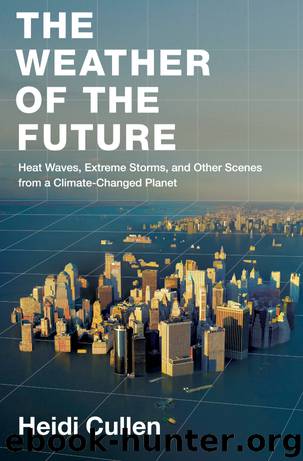The Weather of the Future by Heidi Cullen

Author:Heidi Cullen
Language: eng
Format: epub
Publisher: HarperCollins
Perhaps because of what Gearheard, Pearce, and others have seen personally, many scientists believe that cultural preservation, along with housing and infrastructure improvements, is an important way to help the Inuit simultaneously tackle the issues of climate change and cultural erosion.
The Inuit still hunt narwhals, ringed seals, walrus, beluga whales, arctic char, caribou, polar bears, and a variety of migratory birds.21 But they see changes in wildlife, too. Ringed seals, for instance, are believed to be particularly susceptible to climate change. They depend on the sea ice for pupping and snow cover in spring to build their birth lairs.22 All these conditions will be affected by climate change. Climate change is also likely to increase harvesting pressure on seals; easily accessible year-round near most Nunavut communities, seals become “fallback” prey when hunters cannot reach hunting grounds for other species. Caribou are also believed to be susceptible to climate change.
For the Inuit, climate change means greater risk and greater uncertainty. Their own observations have indicated changes in temperature and precipitation, permafrost, coastal erosion, and ice instability.23 For coastal communities such as Shishmaref in Alaska, perhaps the prime example of climate change in the Arctic, sea ice serves as a buffer against battering waves during severe Arctic storms. Inuit knowledge is already evolving in response to climate change. The increasing unpredictability of the weather and sea ice is becoming part of the collective social memory.
My aunt, Mable Tooli, said [to me]: “The Earth is faster now.” She was not meaning that the time is moving fast these days or that events are going faster. But she was talking about how all this weather is changing. Back in the old days they could predict the weather by observing the stars, the sky, and other events. The old people think that back then they could predict the weather pattern for a few days in advance. Not anymore! And my aunt was saying that because the weather patterns are [changing] so fast now, those predictions cannot be made anymore. The weather patterns are changing so quickly she could think the Earth is moving faster now.
—Caleb Pungowiyi, 200024
Scientists will tell you that climate change is happening faster in the Arctic than anywhere else on the planet. They have been tracking the big picture across the Arctic using every high-tech tool available to them, including satellites and radar. Average temperature has risen almost twice as fast across the Arctic as in the rest of the world during the past few decades. And it’s not just the temperature that is moving fast. There is also a widespread melting of glaciers—and a thawing of permafrost, ground that was until now permanently frozen. Permafrost has warmed almost 3.5°F in recent decades. The warming is affecting villages’ water supply, sewage systems, and infrastructure, as pipes sit aboveground and are vulnerable to any shifts associated with permafrost. The tree line, another boundary distinguishing the Arctic from points south, is creeping north. And snow cover has decreased about 10 percent during the past thirty years.
Download
This site does not store any files on its server. We only index and link to content provided by other sites. Please contact the content providers to delete copyright contents if any and email us, we'll remove relevant links or contents immediately.
How to Do Nothing by Jenny Odell(2658)
A Forest Journey by John Perlin(2597)
The Plant Messiah by Carlos Magdalena(2468)
Babylon's Ark by Lawrence Anthony(2083)
Energy Myths and Realities by Vaclav Smil(2077)
The ESV Study Bible by Crossway Bibles(1991)
Abbey in America by Murray John A(1815)
Fatal Storm by Rob Mundle(1795)
Witness Tree by Lynda V. Mapes(1700)
Shadows on the Gulf by Rowan Jacobsen(1522)
Client Earth by James Thornton(1514)
Brokeback Mountain by Annie Proulx(1478)
Coming Back to Life by Joanna Macy(1472)
Water Rights and the Environment in the United States by John Burch(1420)
Cosmos by Carl Sagan(1412)
Ten Billion by Stephen Emmott(1389)
Mycelium Running: How Mushrooms Can Help Save the World by Paul Stamets(1300)
The overachievers by Robbins Alexandra(1290)
The Uninhabitable Earth by David Wallace-Wells;(1199)
